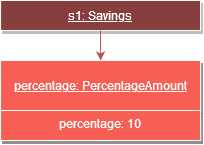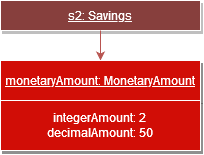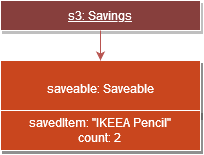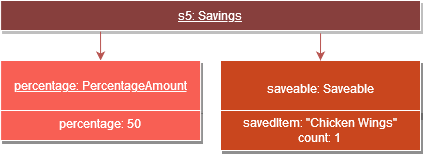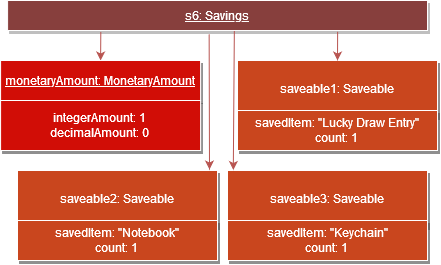By: Team F09-1
- 1. Setting up
- 2. Design
- 3. Implementation
- 4. Documentation
- 5. Testing
- 6. Dev Ops
- Appendix A: Product Scope
- Appendix B: User Stories
- Appendix C: Use Cases
- C.1. Use Case: UC1 - Add Coupon
- C.2. Use Case: UC2 - List all coupons
- C.3. Use Case: UC3 - Mark a coupon as used
- C.4. Use Case: UC4 - Find coupon(s) by keyword(s)
- C.5. Use Case: UC5 - Edit coupon’s details
- C.6. Use Case: UC6 - Set reminder
- C.7. Use Case: UC7 - List coupon(s) expiring before date
- C.8. Use Case: UC8 - Delete coupon
- C.9. Use Case: UC9 - Undo previous command
- Appendix D: Non-Functional Requirements
- Appendix E: Glossary
- Appendix F: Instructions for Manual Testing
- F.1. Launch and Shutdown
- F.2. Adding a coupon
- F.3. Listing coupons
- F.4. Deleting a coupon
- F.5. Editing a Coupon
- F.6. Finding a coupon
- F.7. Sorting the Coupon Stash
- F.8. Listing all expiring coupons
- F.9. Viewing savings
- F.10. Using a coupon
- F.11. Archiving a coupon
- F.12. Copying a coupon
- F.13. Sharing a coupon
- F.14. Undoing a command
- F.15. Going to a month on the calendar
- F.16. Expanding a coupon
- F.17. Setting currency symbol
- F.18. Viewing help page
- Appendix G: Efforts
1. Setting up
Refer to the guide here.
2. Design
2.1. Architecture

The Architecture Diagram given above explains the high-level design of the App. Given below is a quick overview of each component.
-
At app launch: Initializes the components in the correct sequence, and connects them up with each other.
-
At shut down: Shuts down the components and invokes cleanup method where necessary.
Commons represents a collection of classes used by
multiple other components.
The following class plays an important role at the architecture level:
-
LogsCenter: Used by many classes to write log messages to the App’s log file.
The rest of the App consists of four components.
Each of the four components
-
Defines its API in an
interfacewith the same name as the Component. -
Exposes its functionality using a
{Component Name}Managerclass.
How the architecture components interact with each other
The Sequence Diagram below shows how the components interact with each other
for the scenario where the user issues the command delete 1.

delete 1 command.The sections below give more details of each component.
2.2. UI component

API : Ui.java
The UI consists of a MainWindow that is made up of three main parts -
CommandBox, CalendarResultDisplayPanel and a TabsPanel.
All these, including the MainWindow, inherit from the abstract UiPart class.
The TabsPanel can be further divided into three tabs - HelpPane, SummaryPane
and the CouponListPanel. The CouponListPanel contains the CouponCard that
represents the Coupons themselves.
The CalendarResultsDisplayPanel is split into two UI components - the
CalendarPane and the ResultDisplay. As the name suggests, the CalendarPane
holds the calendar that allows easy visualization of expiry dates. The
ResultDisplay provides feedback from Coupon Stash to the user after he runs a
command.
The UI component uses JavaFx UI framework.
The layout of these UI parts are defined in matching .fxml files that are in
the src/main/resources/view folder.
For example, the layout of the
MainWindow
is specified in
MainWindow.fxml
The UI component,
-
Executes user commands using the
Logiccomponent. -
Listens for changes to
Modeldata so that the UI can be updated with the modified data.
2.3. Logic component

API :
Logic.java
-
Logicuses theCouponStashParserclass to parse the user command. -
This results in a
Commandobject which is executed by theLogicManager. -
The command execution can affect the
Model(e.g. adding a coupon). -
The result of the command execution is encapsulated as a
CommandResultobject which is passed back to theUi. -
In addition, the
CommandResultobject can also instruct theUito perform certain actions, such as displaying help to the user.
Given below is the Sequence Diagram for interactions within the Logic
component for the execute("delete 1") API call.

delete 1 Command.
The lifeline for DeleteCommandParser should end at the destroy marker
(X) but due to a limitation of PlantUML, the lifeline reaches the end of
diagram. This limitation affects all of the sequence diagrams in this document.
|
2.4. Model component

API :
Model.java
The Model,
-
stores a
UserPrefobject that represents the user’s preferences. -
stores the Coupon Stash data.
-
some examples of preferences that can be set are the money symbol, or window sizes.
-
-
exposes an unmodifiable
ObservableList<Coupon>that can be 'observed' e.g. the UI can be bound to this list so that the UI automatically updates when the data in the list change. -
does not depend on any of the other three components.
As a more OOP model, we can store a Tag list in Coupon Stash, which a
Coupon can refer to.
This would allow Coupon Stash to only require one Tag object per unique
tag, instead of each Coupon needing their own Tag object.
An example of how such a model may look like is given below. |
+

2.5. Storage component

API :
Storage.java
The Storage component,
-
can save
UserPrefobjects in json format and read it back. -
can save the Coupon Stash data in json format and read it back.
2.6. Common classes
Classes used by multiple components are in the csdev.couponstash.commons
package.
3. Implementation
This section describes some noteworthy details on how certain features are implemented.
3.1. Undo/Redo feature
The undo/redo mechanism is facilitated by with an undo/redo history, stored
internally as an couponStashStateList with a commandTextHistory and
currStateIndex. All these components are encapsulated in the HistoryManager
class.
The following methods in the Model interface facilitates this feature:
-
Model#commitCouponStash(String commandText)— Saves the current coupon stash state and the command text that triggered the change in state intoHistoryManager. -
Model#undo()— Restores the previous coupon stash state fromHistoryManager. -
Model#redo()— Restores a previously undone coupon stash state fromHistoryManager.
3.1.1. Current Implementation
Given below is an example usage scenario and how the undo/redo mechanism behaves at each step.
Step 1. The user launches the application for the first time.
The CouponStash will be initialized with the initial coupon stash state, and
the currStateIndex pointing to that single coupon stash state.

CouponStash will be initialized with the initial coupon stash state.Step 2. The user executes delete 5 command to delete the 5th coupon in the
coupon stash.
The delete command calls Model#commitCouponStash(String commandText),
causing the modified state of the coupon stash after the delete 5 command
executes to be saved in the couponStashStateList, and the delete 5 command
text to be stored in the commandTextHistory. currStateIndex is shifted to
the newly inserted coupon stash state.

currStateIndex is shifted to the newly inserted coupon stash state.Step 3. The user executes add n/OMO STORE … to add a new coupon.
The add command also calls Model#commitCouponStash(String commandText),
causing another modified coupon stash state and command text to be saved into
the couponStashStateList and commandTextHistory respectively.

couponStashStateList and commandTextHistory respectively.
If a command fails its execution, it will not call
Model#commitCouponStash(String commandText), so the coupon stash state and
command text will not be saved.
|
Step 4. The user now decides that adding the coupon was a mistake, and decides
to undo that action by executing the undo command.
The undo command will call Model#undoCouponStash(), which will shift the
currStateIndex once to the left, pointing it to the previous coupon stash
state, and restores the coupon stash to that state. Plus, the command text is
returned, thus allowing for the display of the command that was undone. In this
case, the command undone is add n/OMO STORE….

currStateIndex shifted once to the left.
If the currStateIndex is at index 0, pointing to the initial coupon stash
state, then there are no previous coupon stash states to restore.
The undo command uses Model#canUndoCouponStash() to check if this is the
case.
If so, it will return an error to the user rather than attempting to perform
the undo.
|
The following sequence diagram shows how the undo operation works:

The redo command does the opposite — it calls Model#redoCouponStash(),
which shifts the currStateIndex once to the right, pointing to the previously
undone state and command text, and restores the coupon stash to that state.
Finally, it returns the redone command text.
If the currStateIndex is at index couponStashStateList.size() - 1, pointing
to the latest coupon stash state, then there are no undone coupon stash states
to restore.
The redo command uses Model#canRedoCouponStash() to check if this is the
case.
If so, it will return an error to the user rather than attempting to perform
the redo.
|
Step 5. The user then decides to execute the command list.
Commands that do not modify the coupon stash, such as list, will not call
Model#commitCouponStash().
Thus, the couponStashStateList remains unchanged.

couponStashStateList remains unchanged.Step 6. The user executes clear, which calls Model#commitCouponStash().
Since the currStateIndex is not pointing at the end of the
couponStashStateList, all coupon stash states and command text history after
the currStateIndex will be purged.
We designed it this way because it no longer makes sense to redo the add n/OMO
STORE … command.
This is the behavior that most modern desktop applications follow.

currStateIndex is purged.The following activity diagram summarizes what happens when a user executes a new command text:

3.1.2. Design Considerations
Aspect: How undo & redo executes
-
Alternative 1 (current choice): Saves the entire coupon stash.
-
Pros: Easy to implement.
-
Cons: May have performance issues in terms of memory usage. Plus, have to perform deep copy of coupons when saving the coupon stash so as to prevent unwanted mutations.
-
-
Alternative 2: Individual command knows how to undo/redo by itself.
-
Pros: Will use less memory (e.g. for
delete, just save the coupon being deleted). -
Cons: We must ensure that the implementation of each individual command is correct.
-
Alternative 1 was chosen due to its relative simplicity and extensibility.
Little to no modification needs to be made to each command that can be
undone, thus reducing chances of new bugs surfacing. Additionally, the ability
to undo operations such as clear will require alternative 2 to copy the
entire coupon stash too, so both alternatives will have the same memory
footprint in such a context. Finally, the real world performance impact of
copying all coupons vs copying one is not very huge. Thus, the more
extensible and simpler alternative 1 was chosen.
3.2. Calendar
3.2.1. Current Implementation
The Calendar component provides a visual representation of the stored coupons that are expiring over a month. It is
facilitated by CalendarPane, DateCell, ObservableList<Coupon> and ObservableMonthView.
The CalendarPane is the controller of the Calendar on display. Users can change the month on display to show the coupons
that expire during a specific month year by clicking on the arrows at the sides of the calendar’s title or
by using the goto command.
Each DateCell represents each date of the month that is currently on display. Each DateCell uses the
ObservableList<Coupon> to keep a list of the coupon(s) that expires on each date. A DateCell with coupon(s) expiring
on the date are highlighted in red and a Datecell that represents the system’s date is highlighted blue.
The ObservableList<Coupon> is the list of filtered coupons that are currently on display in the CouponListPanel.
They are obtained by calling the Logic#getFilteredCouponList() method. The list can be filtered to view all active,
archived or used coupons using the expiring command .
The ObservableMonthView is the current month & year on display in the Calendar Pane. It is obtained by calling
the Logic#getMonthView() method.
The class diagram below shows the interaction between classes that affects the Calendar:

The sequence diagrams below show how the Calendar works:
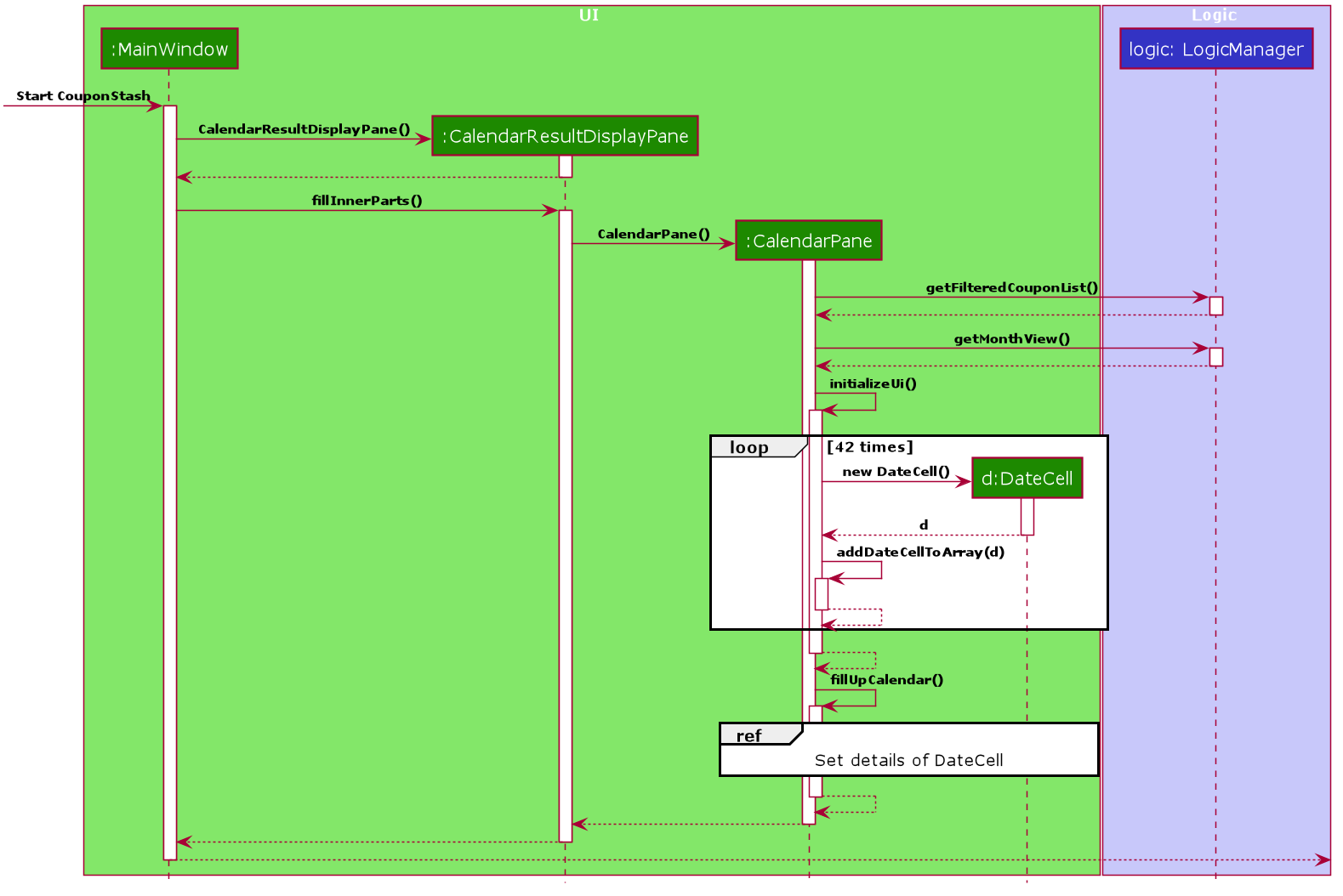
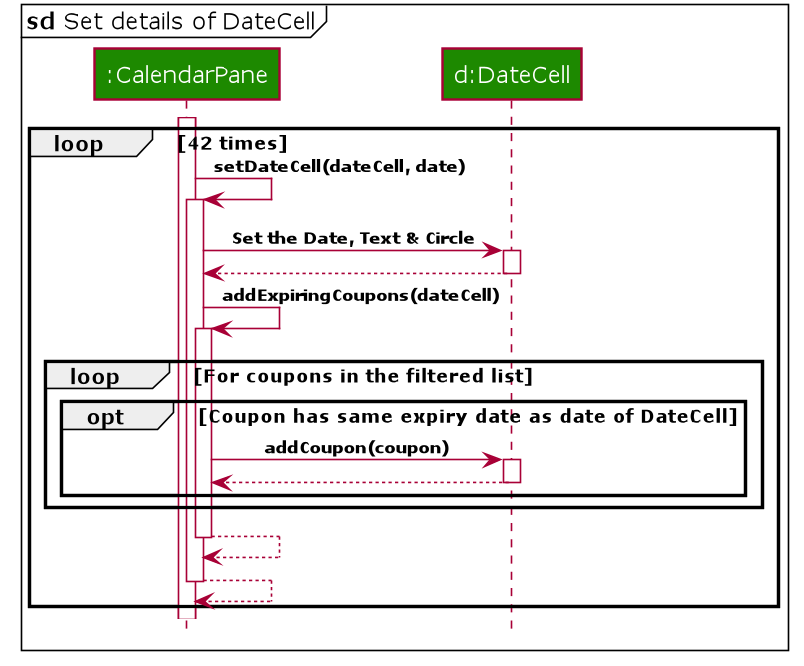
The two scenarios below are examples of how the Calendar mechanism behaves at each step of each scenario.
Updating the Calendar with an Updated List
The Calendar updates with the current ObservableList<Coupon> with commands such as the add, archive, clear,
delete, edit, expiring, find, list, redo, unarchive, undo and used. The following steps describes how
this behavior is implemented.
Step 1. The user launches the application for the first time.
The Calendar displayed will render the saved coupon data, triggered by the initiation of the UiManager.
Step 2. The user executes a command that alters the ObservableList<Coupon> (any command listed above).
When a command alters the observable coupon list, the listener of the observable list detects the change and the
Calendar will be updated accordingly to the list by calling the CalendarPane#fillUpCalendar() method.
For example, the find command alters the observable coupon list. It calls the FindCommand#execute(Model, String)
method, which calls the Model#updateFilteredCouponList(Predicate) method. It then calls the
FilteredList<Coupon>#setPredicate(Predicate) method that alters the observable coupon list.
If a command fails its execution, it will not call the FilteredList<Coupon>#setPredicate(Predicate) method. Hence, the
observable coupon list will not be altered and the calendar will not be altered.
|
The following sequence diagram shows how the Calendar updates with the observable coupon list:

Updating the Calendar with a Different Month View
The Calendar updates with the current ObservableMonthView with commands such as goto, expiring and list or by
clicking on the arrows at the sides of the calendar title. The following steps describes how this behavior is
implemented.
Step 1. The user launches the application for the first time.
The Calendar displayed will render the saved coupon data, triggered by the initiation of the UiManager. The default
calendar display will be set to the system’s month year.
Step 2. The user executes a command that alters the ObservableMonthView (any command listed above).
When a command alters the observable month view, the listener of the observable month view detects the change and the
month view display of the calendar will be updated according by calling the CalendarPane#updateCalendarWithYearMonth
method.
For example, the goto command calls the GoToCommand#execute(Model, String) method, which calls the
Model#updateMonthView(String) method. It then calls the ObservableMonthView#setValue(String) method that alters the
observable month view.
-
expiringcommand-
For the
expiringcommand, the Calendar will be updated accordingly to the month year of the specified date or month year with the command. -
For example, entering these
expiringcommandsexpiring my/9-2020orexpiring e/11-9-2020will change the month year on display to September 2020.
-
-
listcommand-
For the
listcommand, the Calendar will be updated to thesystem’s month year.If a command fails its execution, it will not call the ObservableMonthView#setValue(String)method. Hence, the observable month view will not be altered and the calendar will not be altered.
-
The following sequence diagram shows how the Calendar updates with the observable month view:
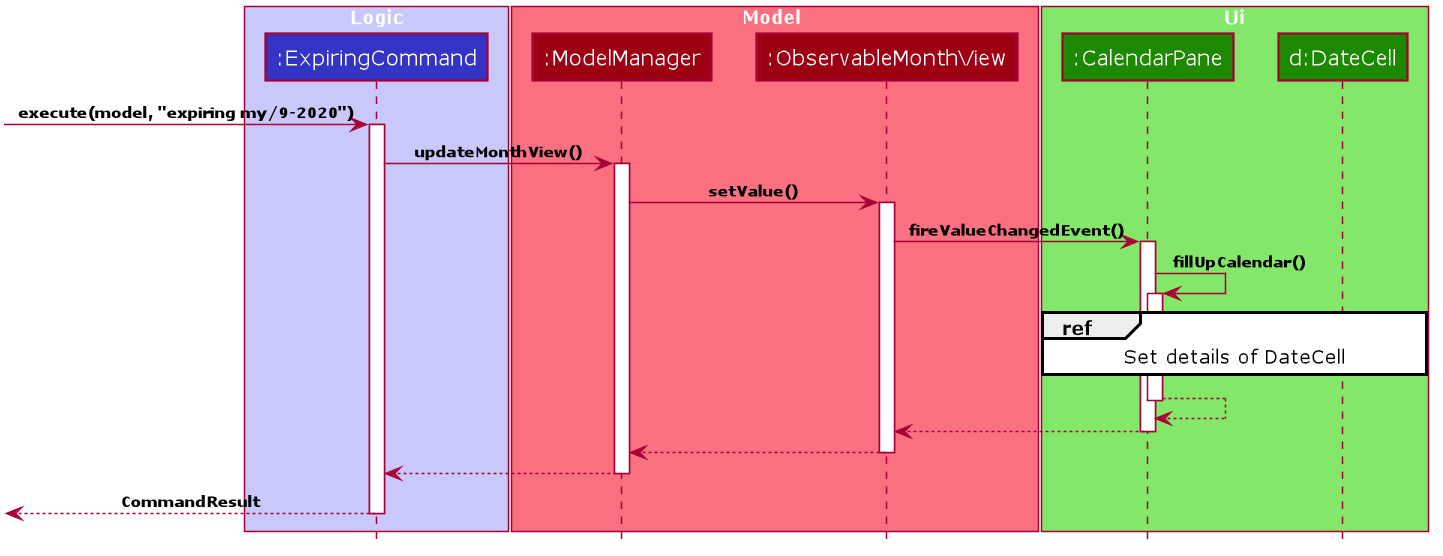
Or alternatively, instead of step 2,
Step 3. The user clicks on the arrows at the sides of the calendar title to change the month year displayed.
When a click alters the observable month view, the listener of the observable month view detects the change and the
month view display of the calendar will be updated according by calling the CalendarPane#updateCalendarWithYearMonth
method.
For example, clicking on the arrow on the right calls the CalendarPane#changeCalendarToNextMonth method, which calls
CalendarPane#updateCalendarToNextMonth. It then calls the ObservableMonthView#setValue method that alters the
observable month view.
3.2.2. Design Considerations
Aspect: Information displayed on the Calendar
-
Alternative 1 (current choice): Show expiring coupons by highlighting the dates with expiring coupon(s)
-
Pros: Cleaner view of the Calendar with minimal information & may take up less space on the
Main Window -
Cons: Lesser information provided with a glance
-
-
Alternative 2: Show a condensed version of the coupons' details within the cell of each date
-
Pros: More information provided with a glance
-
Cons: Messy to look at when there are multiple coupons expiring on a date & may take up more space on the
MainWindow
-
We decided on alternative 1, to show coupons expiring on specific dates with highlights. This is because a coupon contains
much information and the calendar may look cluttered and messy, which may be aesthetically unpleasant to the user.
Furthermore, the user can use the expiring command to search for coupons expiring on a date or month year and have a
more detailed view of the coupons in the CouponListPanel.
Aspect: Whether the Calendar should update with the list
-
Alternative 1 (current choice): Calendar updates with the filtered list
-
Pros: User can easily relate and reference to the coupons shown in the Calendar to the
CouponListPanel -
Cons: May overlook some coupons if the list is filtered
-
-
Alternative 2: Calendar shows all the coupons in CouponStash
-
Pros: View of all coupons and will not overlook any coupons even when the coupon list is filtered
-
Cons: User may be confused if he/she sees a highlighted date on the Calendar when there is no coupon expiring on that date in the
CouponListPanel
-
We decided on alternative 1, for the calendar to update with the list in the CouponListPanel. This is because this
follows the Observer Pattern Design Principle. Furthermore, this will not confuse the user when the user sees a
highlighted date on the Calendar when there is no coupon expiring on that date in the CouponListPanel.
3.3. Coupon Archiving
When physical coupons are expired or exhausted, they would usually be thrown away, or kept in the archive. Coupon Stash simulates this archive, storing these coupons in the app so that the user can still keep track of it, and the savings they generated.
3.3.1. Current Implementation
The archiving of coupons is facilitated by the Archived attribute of a
coupon. The following methods in the CouponStash,
Coupon, Usage, UsedCommand class and the Model interface facilitates this feature:
-
CouponStash#archiveExpiredCoupons()— Archives any coupon in theCouponStashthat has expired, and returns a new updatedCouponStash. -
Coupon#increaseUsageByOne()- Increases the usage of a coupon by one. -
Usage#isAtLimit- Returns true if the current usage is at its limit (abstracted by theLimitfield). -
UsedCommand#execute()- Executes theusedcommand input by the user. -
Model#PREDICATE_SHOW_ALL_ACTIVE_COUPONS- APredicatefunction that filters out archived coupons from a givenCouponStash.
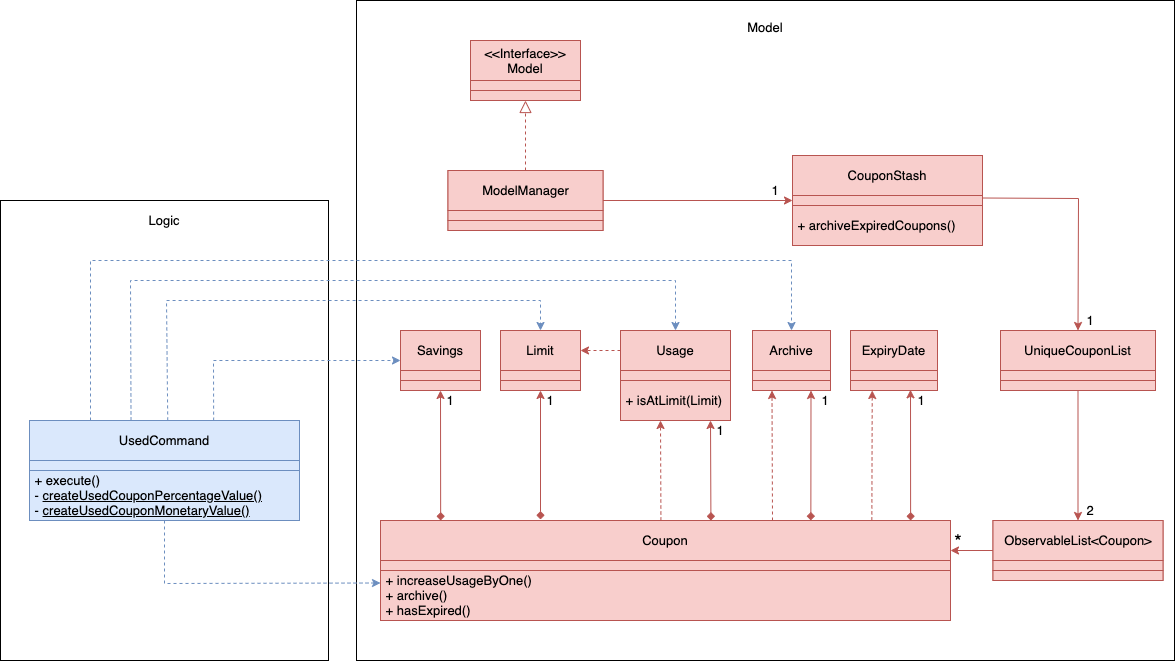
Given below is two example usage scenarios and how the archiving mechanism behaves at each step of each scenario. An activity diagram is provided first to describe the general events that will lead to an automatic archiving of coupons by Coupon Stash.
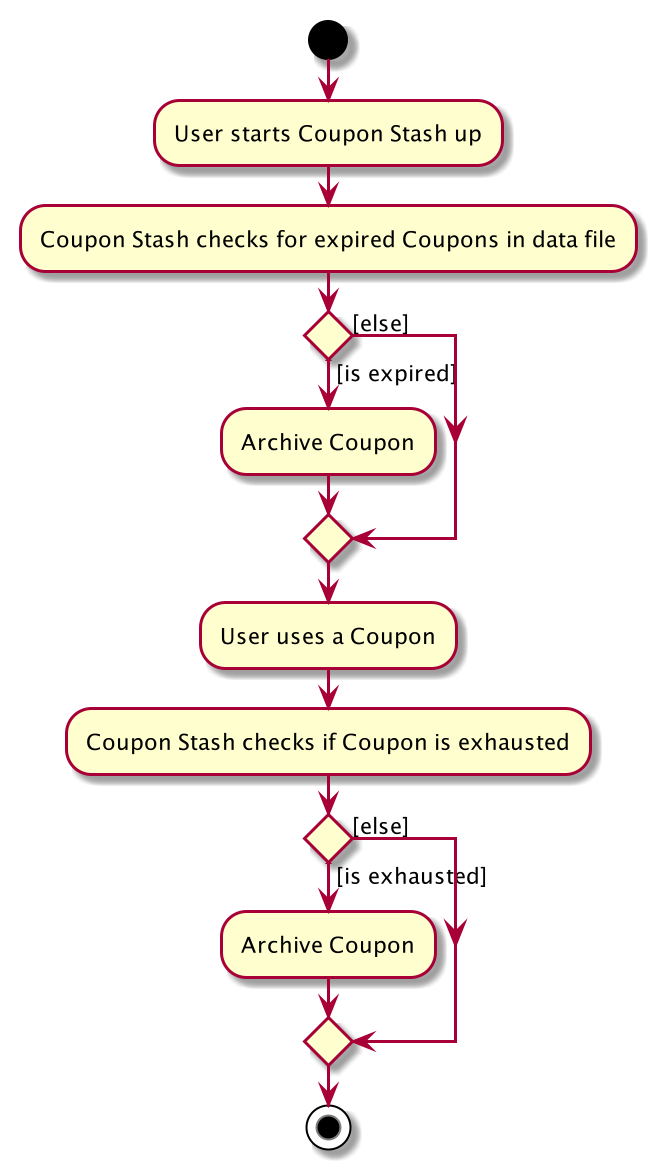
Archiving of Expired Coupons
Expired coupons are automatically archived by Coupon Stash upon start up of the application. The following steps describe how this behaviour is implemented.
Step 1. The user launches the application for the first time. The initiation of
ModelManager will also trigger the
initiation of CouponStash with any available saved data.
Step 2. The method CouponStash#archiveExpiredCoupons will be called from the
newly initiated CouponStash, and have its
UniqueCouponList mapped to a function that archive coupons that has expired
before the date of opening the application, and returns a new updated CouponStash.
This mapping function is facilitated by Coupon#hasExpired() and Coupon#archive().
Step 3. The ModelManager will proceed to filter out the archived coupons from
the newly updated CouponStash, and return
a filtered list of active coupons. This filtering is facilitated by the
predicate Model#PREDICATE_SHOW_ALL_ACTIVE_COUPONS.
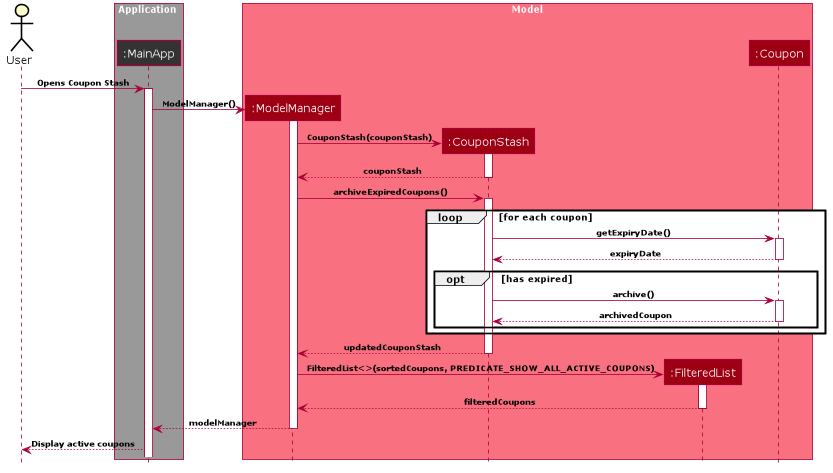
Archiving of Exhausted Coupons
Coupons that have exhausted its usages will be automatically archived by the application. The following steps describe how this behaviour is implemented.
Step 1. The user uses a Coupon in the current observable CouponStash with the
command used 1.
UsedCommand is created with the parsed arguments, and executed. The particular Coupon
will then have its Usage increased by one by calling Coupon#increaseUsageByOne().
Step 2. The Coupon will then be checked if its Usage has reached its Limit, using
the Usage#isAtLimit() method. For the purpose of this explanation, we assume that
the coupon being used has a usage Limit of 1 and a previous Usage value of 0,
with savings in MonetaryAmount.
Step 3. The Coupon will have a new Archived value, which will be set to
true if the Usage has indeed reached its Limit. This is facilitated by Coupon#archive().
Step 4. The CouponStash will be updated with this used Coupon with the
ModelManager#setCoupon() method. Under the hood of
this method, the current FilteredList will be updated to show active
Coupons only, facilitated by the predicate
Model#PREDICATE_SHOW_ALL_ACTIVE_COUPONS.
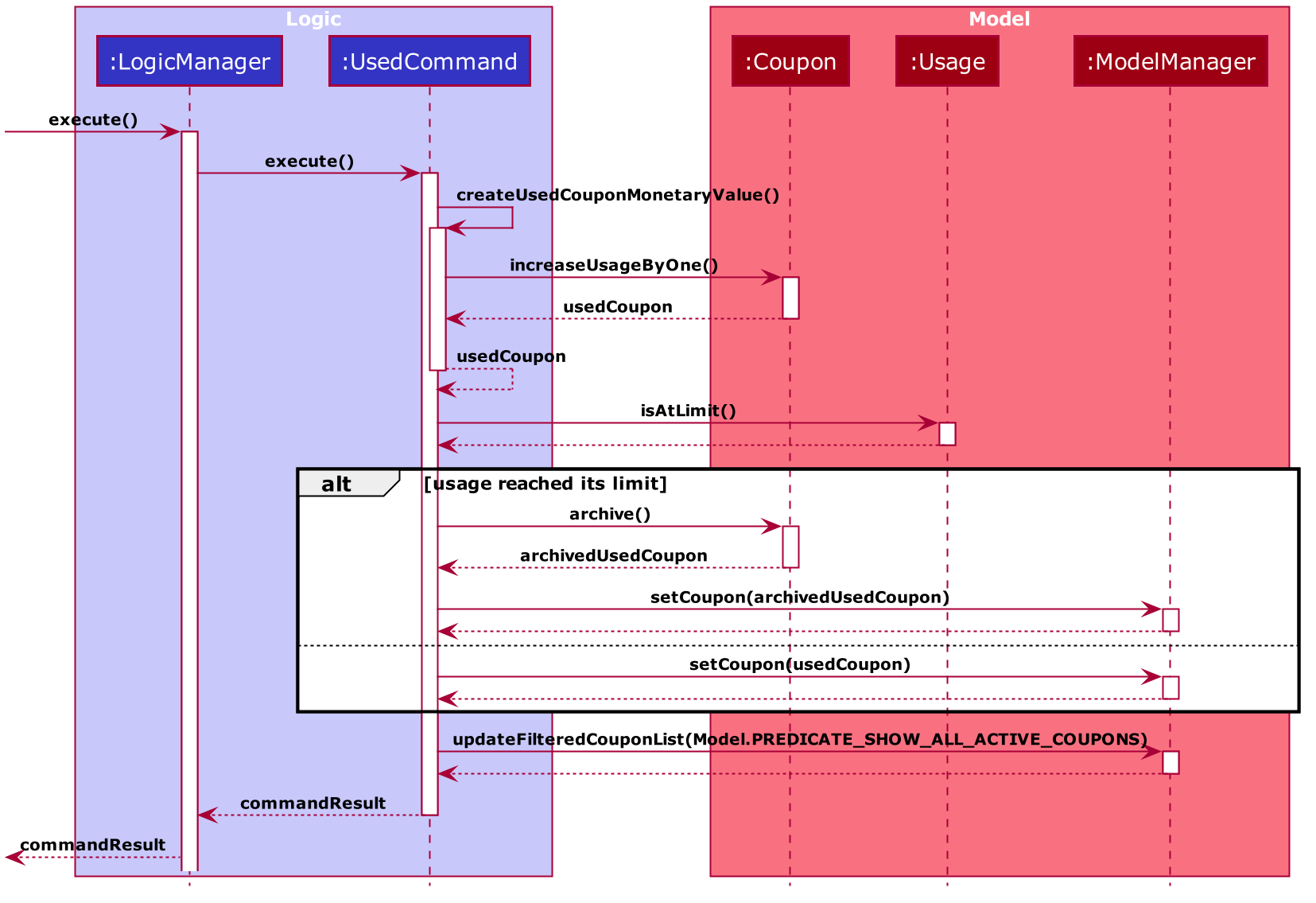
3.3.2. Design Considerations
Aspect: The implementation to store archived coupons
-
Alternative 1 (current choice):
Couponcontains anArchivedfield-
Pros: Easy to implement, lower maintainability.
-
Cons: Saved data may get get considerably huge after heavy usage of application.
-
-
Alternative 2: Archived
Coupons are stored in another separate data file.-
Pros: Separates the logic between the two different
CouponStash, e.g. ability to limit the functions on archivedCoupons -
Cons: Sharply increases the maintainability and coupling of the application with two data files.
-
Alternative 1 was chosen, due to the cons of Alternative 2. While a separate
file is akin to having two separate stashes of coupons, this would increase
the overall complexity of the application. Logic and Model would have to
deal with another set of data, and Commands may have to split up the logic
for different data sets. Furthermore, while saved data will be larger for
Alternative 1, it should only affect the performance of starting Coupon Stash
up, since most of the interactions with the program is with active coupons.
3.4. Up/down arrow retrieve command history
3.4.1. Current Implementation
The retrieving of command history via the up and down arrow keys is facilitated
by the CommandTextHistory class. The command history is stored internally as
a LinkedList used as a stack with a currIndex
tracking the next command in the history to return.
The following methods and attributes in the CommandTextHistory
class facilitates this feature:
-
CommandTextHistory#add(String commandText) -
CommandTextHistory#getDown() -
CommandTextHistory#getUp() -
CommandTextHistory#commandTextHistory -
CommandTextHistory#currIndex
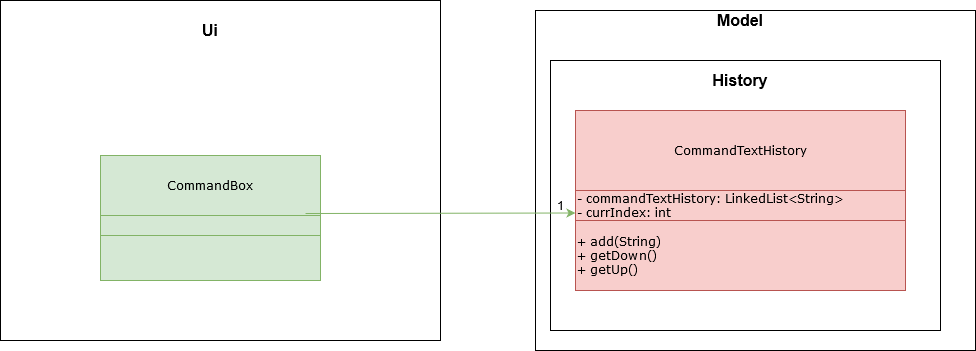
Given below is an example usage scenario and how the up/down button presses behaves at each step.
Step 1. The user launches the application for the first time. The
CommandTextHistory is initialized
with a stack containing only an empty string (""), and the currIndex
is set to 0.
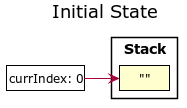
Step 2. The user executes delete 1. CommandBox#handleCommandEntered() will
call CommandTextHistory#add(String commandText) to save the entered command
into
the stack contained in CommandTextHistory. The top of the stack (i.e. the
empty string) is popped off first, before
the entered command is pushed onto the stack. Then, the empty string is pushed
onto the stack again, thus ensuring that
the empty string stays at the top of the stack. Note that currIndex is not
affected.

delete 1Step 3. The user executes delete 2. CommandBox#handleCommandEntered() will
also save the entered command into
the stack contained in CommandTextHistory. As in the previous step, the new
command is pushed to the top of the stack,
just below the empty string.
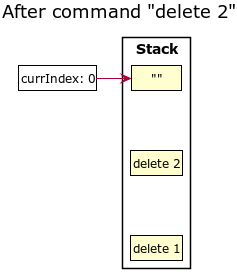
delete 2.Step 3. Now, the user decides to delete the second coupon again. We press the
arrow key up once,
and CommandBox#commandTextField has a listener that calls
CommandTextHistory#getUp().
The currIndex is incremented, and then the command text pointed to by
currIndex is returned and
displayed in the program command box.
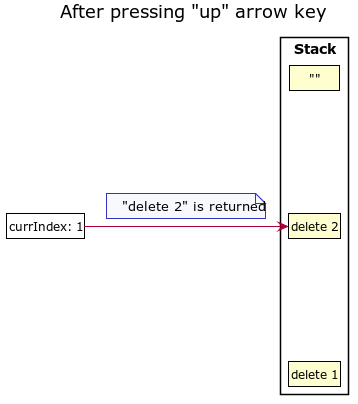
Step 4. The user then executes the retrieved command (delete 2). As in the
previous steps, this newly executed command
is pushed to the top of the stack just below the empty string. However, in such
a case when the currIndex is not 0 and
does not point to the top of the stack, it is reset to 0.

delete 2 again.
If the currStateIndex is pointing to the top of the stack,
then there are no previous commands to retrieve. Thus, the up button will simply
return the empty string. No changes to the stack and currIndex will be
effected.
|
The down arrow key does the opposite, it will lead to the calling of
CommandTextHistory#getDown(),
which shifts the currIndex one item higher (i.e. decrement the currIndex by
1), before returning
the command text pointed by the updated currIndex.
If the currIndex is at index commandTextHistory.size() - 1, pointing to the
bottom of the stack, there is no next command to retrieve when pressing the
down key. Thus,
the down button will simple return the command text currently being pointed to
by the currIndex.
No changes to the stack and currIndex will be affected.
|
Below is a sequence diagram describing the events that happen when a user presses a key.
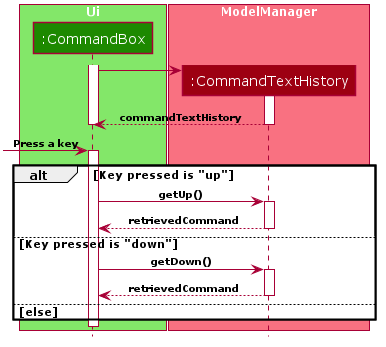
Below is a sequence diagram describing the events that happen when a executes
a command text, thus triggering the saving of a command text into
CommandTextHistory.

3.4.2. Design Considerations
Aspect: Data structure to support the key actions
-
Alternative 1 (current choice): Use
LinkedListas a stack to store the command text history.-
Pros:
LinkedListis a better data structure that allows for more efficient operations supported by stacks.
-
-
Alternative 2: Use
ArrayListas a stack to store the command text history.-
Pros:
ArrayListis more recognizable to people who are relatively new to Java, thus reducing confusion. -
Cons: Stack operations are less efficient on
ArrayLists.
-
3.5. Coupon Sorting
3.5.1. Current implementation
The sorting of coupons in the coupon stash is facilitated by the following
static variables in the SortCommand class and this methods in the Model
interface and SortedList class.
-
SortCommand#NAME_COMPARATOR- Comparator that sorts coupons by name in ascending order. -
SortCommand#EXPIRY_COMPARATOR- Comparator that sorts coupons by expiry date in ascending order. -
SortCommand#REMINDER_COMPARATOR- Comparator that sorts coupons by remind date in ascending order. -
Model#sortCoupons(Comparator<Coupon> comparator)- Sorts theObservableListof coupons that are stored inModelaccording to the order decided by the passed incomparator. -
SortedList#setComparator(Comparator<Coupon> comparator)- Sets the comparator that determines the order of the coupons inside the sorted list.

When a sort command is executed, the field to sort by is indicated by the
inputted prefix. The sequence diagram below describes what happens when a
sort command is run.

Depending on the prefix to sort by, ModelManager#sortCoupons() will be
called with the relevant comparator as its argument. The
ModelManager#sortCoupons() method subsequently calls the
SortedList#setComparator() method (not shown in the above diagram), which
leads to a change of the comparator of the SortedList stored in
ModelManager , thus triggering a sort of the SortedList.
3.5.2. Design Considerations
Aspect: Persistent or non - persistent sort?
-
Alternative 1 (current choice): Make sorting non - persistent.
-
Pros: Sorting is faster as no write to disk is needed to make the new order persistent. Additionally, with the coupons being sorted by the time they are added to the coupon stash by default, there is no way to restore this order without storing the time a coupon was added to the stash. Thus, the non - persistent approach shines here as restoring the original order of the coupon stash is as trivial as reopening the program.
-
Cons: If a user prefers a particular default sorting order for their coupons, they have to retype the
sortcommand each time the program is launched or each time a coupon is added or edited.
-
-
Alternative 2: Make sorting persistent.
-
Pros: Gives users more freedom over the default order of their coupons.
-
Cons: Can be unnecessarily complicated to implement a hidden field stating a coupon’s addition time just so users can revert to the default order. Additionally, it can be confusing to users when there are so many different ways to sort.
-
In our usage during testing, we have never had the urge to have a default sorting order when the program is launched. Plus, we feel that the simplicity of excluding a sort by default order function will be well favored by users, and thus we chose alternative 1.
3.6. Coupon Reminder
To ensure users are aware of expiring coupons and maximise their saving, Coupon Stash reminds the user through a pop-up window, upon launching the application.
To achieve this feature, the following methods in the RemindDate and
RemindWindow classes are used.
-
RemindDate#isToday()- Check if theRemindDateis today. -
RemindWindow#filterRemindCoupons()- Filters out allRemindDatesthat are not today fromRemindWindow. -
RemindWindow#constructRemindCoupons()- Creates aStringof coupons that have theirRemindDatestoday. ThisStringis used in the displayed reminder window. -
RemindWindow#showIfAny()- Shows the reminder window if there are coupons to be reminded of today. If there are no coupons that have to be reminded today, no window will be shown.

To make sense of how coupon reminder functions, let’s dive into the specifics of RemindDate class, RemindCommand class and RemindWindow class.
3.6.1. Implementation of editing a coupon’s RemindDate
The following activity diagram depicts what happens when the user runs a
edit command to edit a coupons’s RemindDate.

remind date of a coupon.3.6.2. Implementation of reminder pop up
After establishing the remind dates for all the coupons, the next step is ensure that there will be a reminder pop up (if necessary) upon opening the application.
The following steps describe how to reminder pop up works:
-
The user launches Coupon Stash. The
startmethod inMainAppclass will kick start the program by setting up the stage, along with the saved data. -
This will trigger the
startmethod inUiManager, which leads to the creation of a newRemindWindowinstance, with aListof all coupons currently stored passed in as a parameter. -
In the constructor of
RemindWindow, coupons that do not have a remind date of today are filtered out. -
After filtering the coupons, if there are coupons to be reminded today, their information will be concatenated into a
Stringthat is displayed in the reminder window.

3.6.3. Design consideration
Aspect: How to keep track of coupon remind date
-
Alternative 1 (current choice): Coupon contains a
Remindfield.-
Pros: Code implementation is easier and this makes the remind date more visible to the user since it is a field.
-
Cons: Coupon display may get very cluttered with the addition of this extra field.
-
-
Alternative 2 : Store the remind dates of all coupons in a separate data file. Coupons can be stored in a hash table with their remind dates as keys.
-
Pros: No need to clutter coupon display with additional fields. Plus, it is efficient to list all coupons that have to be reminded for on a certain day as the coupons are stored in a hash table.
-
Cons: Hard to maintain two separate data files that have shared components (in this case coupons)
-
All in all, we chose alternative 1 as we feel that it is good for users to be able to view the remind date of a coupon in the coupon view. Additionally, all speed-ups and efficiency of storing the remind dates in a separate data file is nullified by the fact that we still need to loop through all coupons to display their remind dates on the calendar component. Thus, to make it easier to extend the program in the future, we decided against adding another data file which can make extension more complicated, and chose to work with alternative 1.
3.7. Savings per use and total amount saved
To allow users to keep track of how much they have saved (after all, the whole point of coupons is to offer certain tangible benefits, encouraging purchases by customers), Coupon Stash automatically tracks the user’s savings as they use their coupons that are handled in the application.
To achieve this, Coupons have to store two different
fields:
1. Amount of savings each use of a coupon provides
2. Total amount of savings accumulated
from using a certain coupon
3.7.1. Class structure of Savings
Just for reference, the image below shows the class diagram
for the Savings class. It is compulsory for each Coupon to
contain an Savings object, that represents what the user
would gain from 1 use of that Coupon.

Savings.A Savings object can hold a PercentageAmount, MonetaryAmount or
Saveables, which represents discounts like "$5 off", "10% off"
and "free door gift" respectively.
The table below shows which are valid Savings objects, and which are not.
Object Diagram |
Comments |
Savings with percentage amount.
|
Valid |
Savings with monetary amount.
|
Valid |
Savings with saveable items.
|
Valid |
Savings without any fields present.
|
Invalid: |
Savings with percentage amount and a saveable item.
|
Valid: |
Savings with monetary amount and multiple saveable items.
|
Valid: |
Savings with monetary amount and percentage amount.
|
Invalid: Savings cannot have both a
|
As can be seen from the table, Savings cannot be completely
empty, and Savings cannot have both a MonetaryAmount and
PercentageAmount (it does not make much sense to have
a voucher that says "10% and $5 off").
3.7.2. PureMonetarySavings and DateSavingsSumMap
In order to calculate the total amount saved, Coupons also
store information about how much the user saves, and storage
is done at the moment the user uses the coupon. This
information is stored in the form of PureMonetarySavings,
which is a subclass of Savings that never holds
PercentageAmounts. The class diagram below illustrates this.
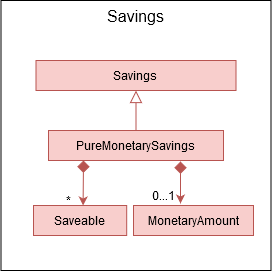
PureMonetarySavings.The reason why PercentageAmounts are not allowed in
accumulated savings is because a percentage
discount is a relative value that depends on the
original price of the product, and cannot be easily
added up in a way that allows users to accurately
measure how much they have saved from their coupons.
PureMonetarySavings are stored in
a DateSavingsSumMap, which is a hash table that
links the current date (LocalDate) to the savings
earned (PureMonetarySavings) on that date.
Each Coupon holds a DateSavingsSumMap. The
next image shows the class diagram of the
DateSavingsSumMap.
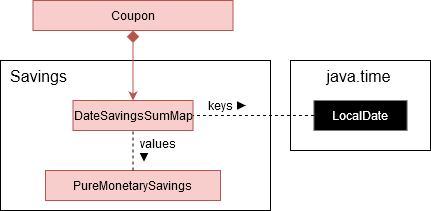
DateSavingsSumMap.The following section describes
the processes that follow whenever a user marks a Coupon
as "used" with the used command.
3.7.3. Implementation of used command
When the user enters a used command, the actions taken by Coupon
Stash change depending on whether the Coupon’s Savings stores
a MonetaryAmount of PercentageAmount. The following activity diagram
shows what happens when the user runs a used command.
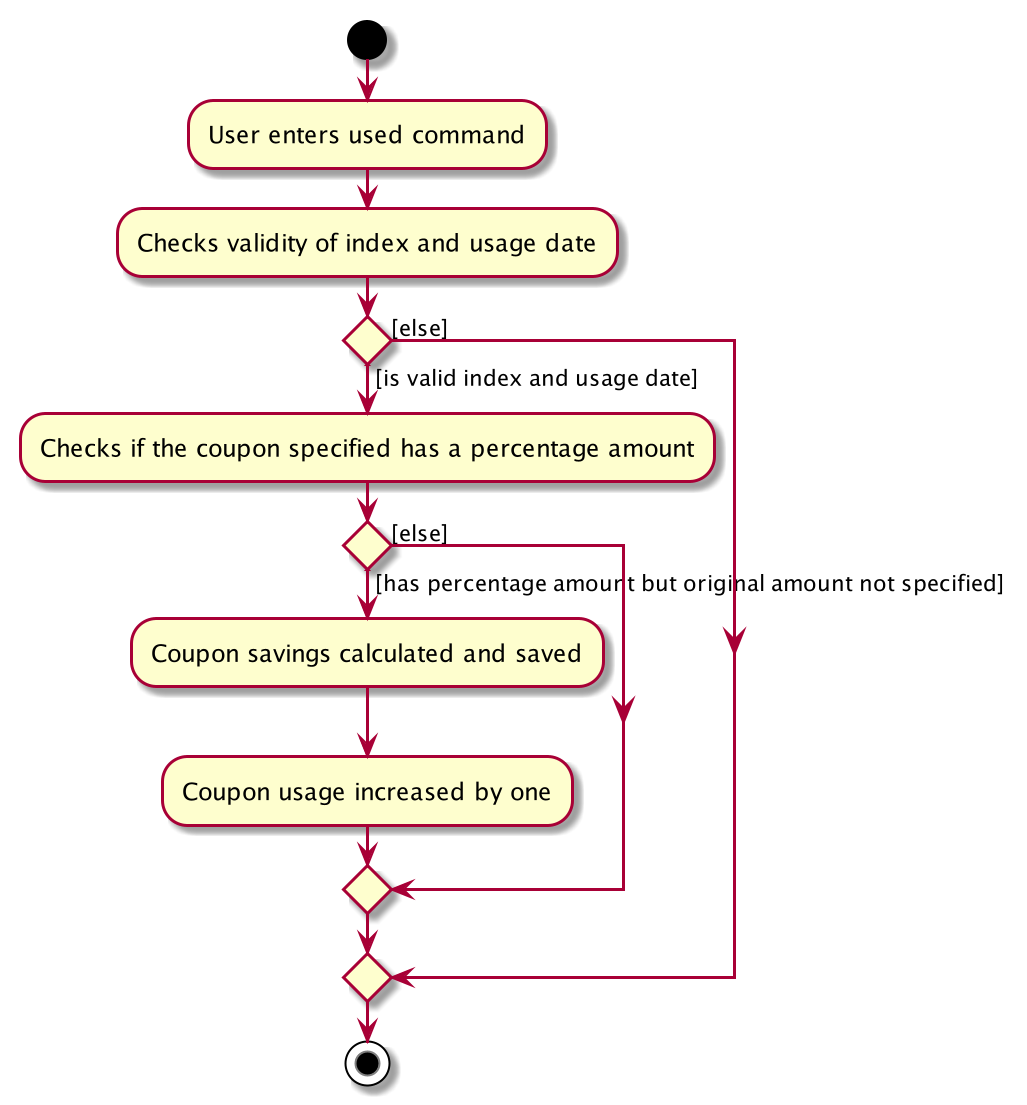
In terms of the implementation, the next two images shows the sequence diagram that models the successful execution of a used command within the actual program components.
More specifically, the used command executed is
used 1 $100, and the state of the system is such that
a Coupon with PercentageAmount in its Savings (no
MonetaryAmount) and with Usage not at its Limit
is located at index 1. Also, the money symbol
set in the user preferences would be $, which
makes this command a valid one that will execute
successfully.
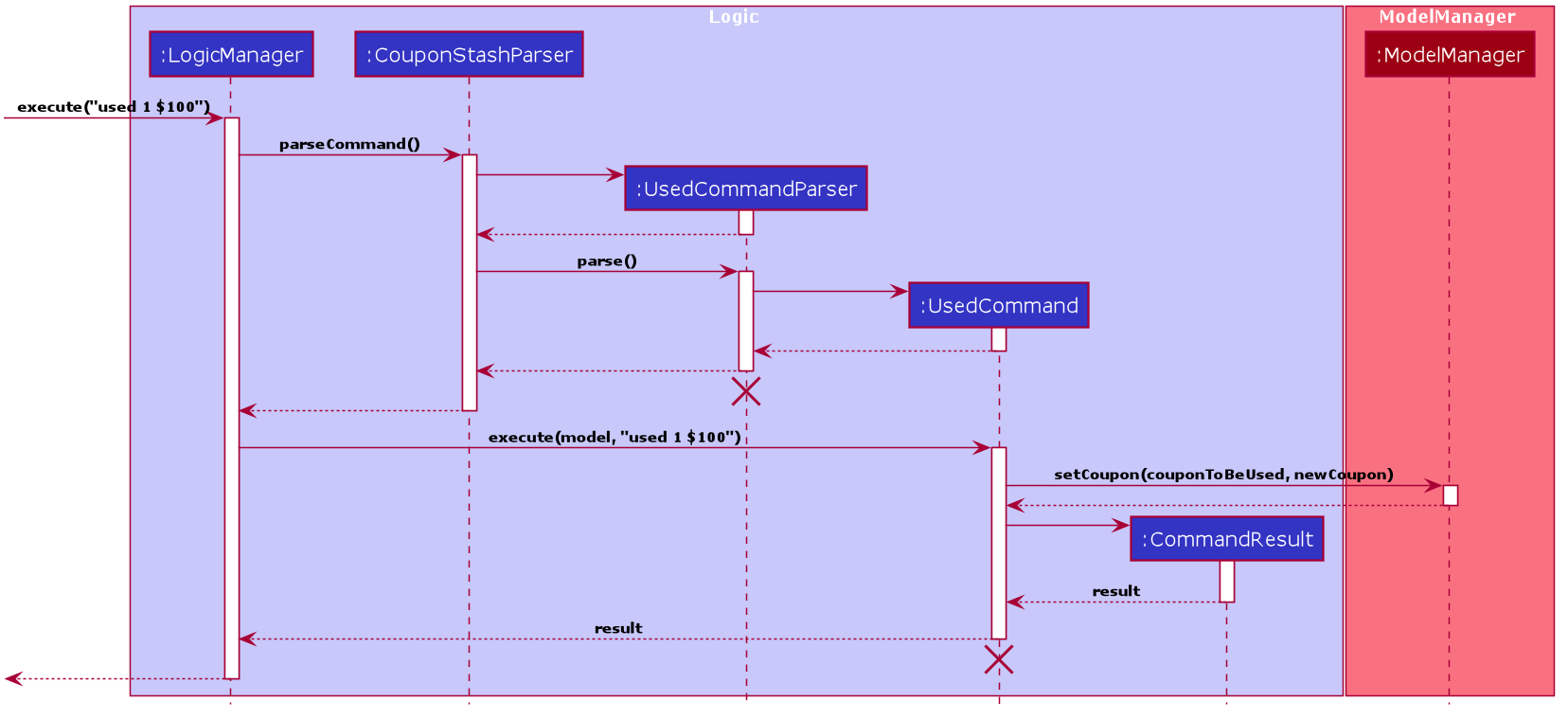
UsedCommand is executed.The money symbol set in the user preferences is
retrieved by CouponStashParser, which passes it
to UsedCommandParser that will use this symbol
to parse the used command.
Also, within UsedCommand, the UsedCommand#execute() method
will cause the creation of a new Coupon with the
correct recorded number of uses and amount of
savings earned. The next sequence diagram shows
how a successful UsedCommand#execute() method produces the new total savings
value for the new Coupon.
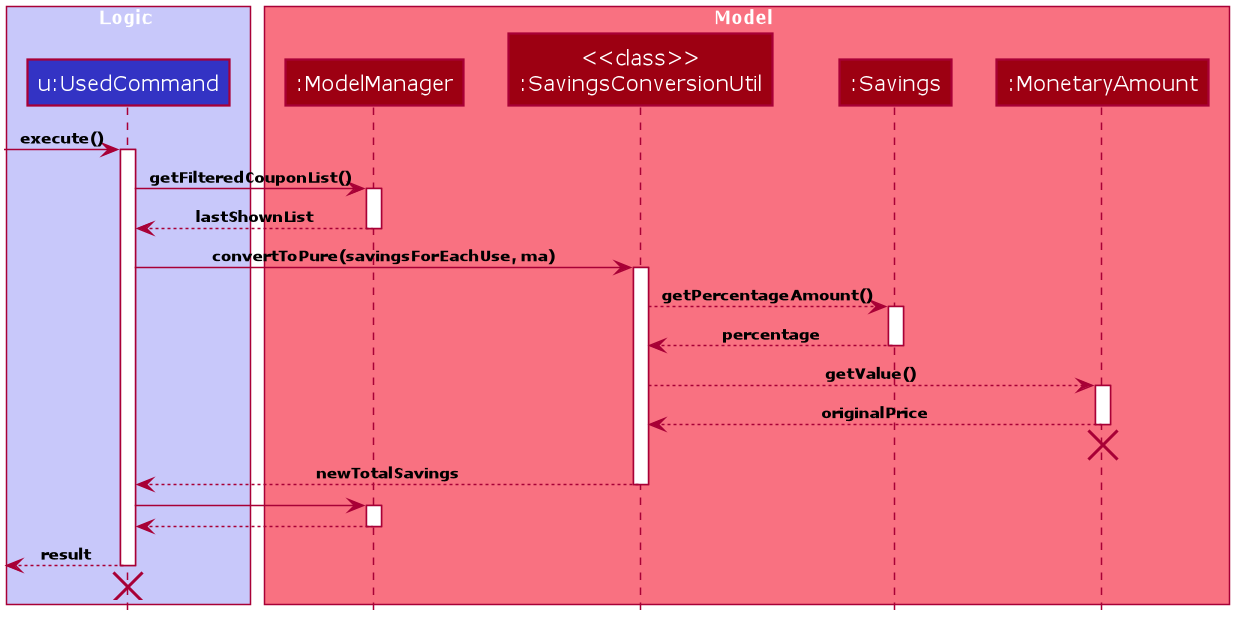
UsedCommand updates the total savings.In the end, the total savings value of the Coupon
is updated. This total savings is represented by
a DateSavingsSumMap.
One key implementation within the UsedCommand is the checks
that it has to make to ensure the valid usage of a Coupon.
Below is an activity diagram to show the flow of checks within
the UsedCommand#execute() method.
3.7.4. Implementation of saved command
Now that we have seen how the used command works,
we can look at how the saved command works. While
used stores the amount of savings that the user
has earned on a particular day, saved retrieves
the amount of savings earned as recorded by Coupon
Stash, given a particular time period.
The saved command works similarly to the used command,
where a SavedCommandParser will be created by Logic
to split up the raw String into its arguments,
creating a SavedCommand. Let’s look at how a SavedCommand
would be executed.
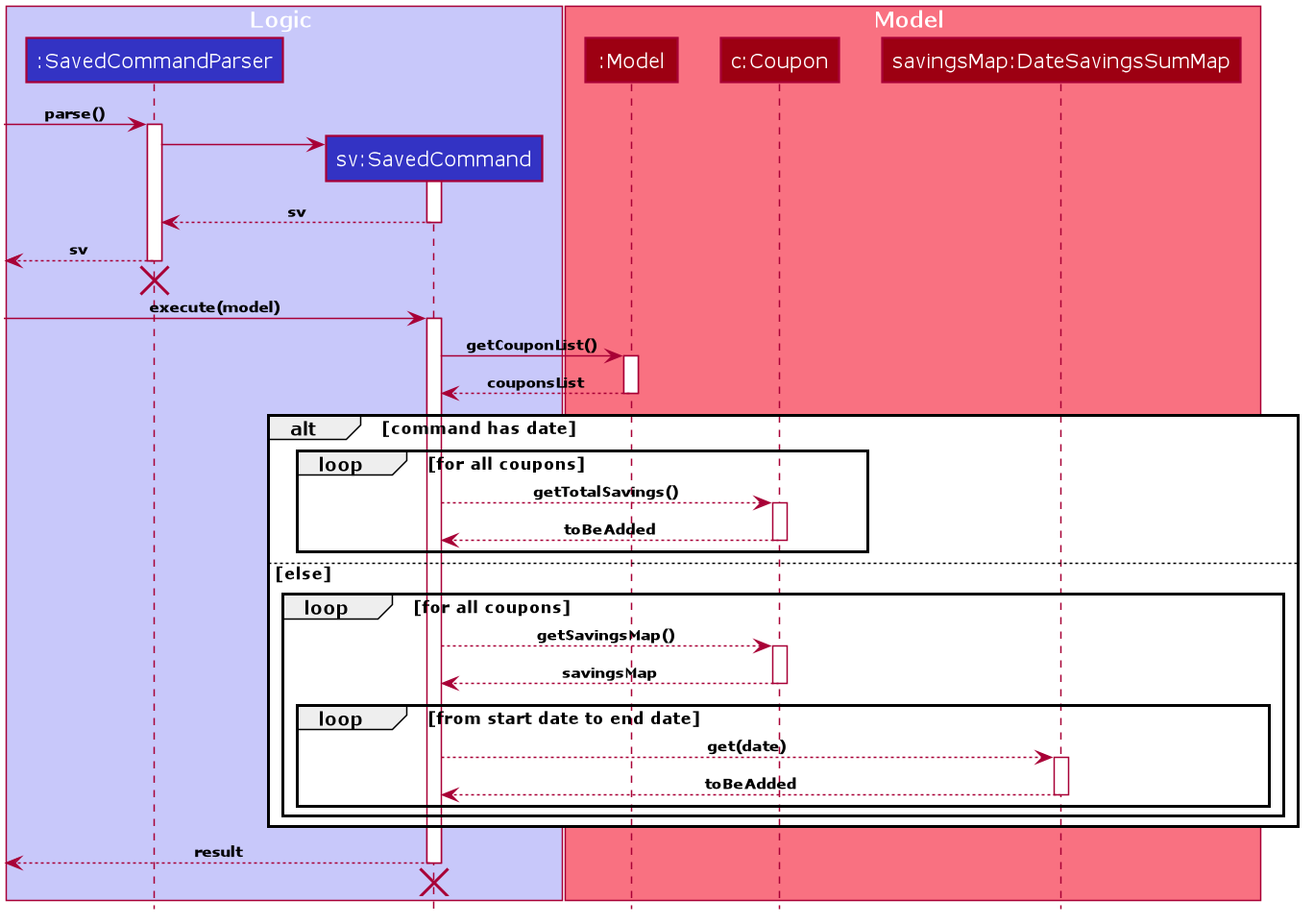
SavedCommand.Hence the SavedCommand loops through all Coupons to add
up the savings earned from a particular time period,
or from all dates if no time period is specified.
3.7.5. Design considerations
Based on the User Stories, there is a desire for tracking how much one has saved by using Coupon Stash, as well as for viewing total savings easily. Below are some alternative implementations of savings tracking and viewing that were considered by the developers, but were rejected in favour of the current implementation.
Alternatives:
-
Restrict each
Savingsto a concrete monetary value
This would make the implementation of Savings much
simpler, as there would not be a need for separate
classes like PercentageAmount, MonetaryAmount and
Saveables. However, this might burden the user with
calculating how much they would save in terms of
dollars and cents, when many coupons and discounts
come in the form of certain percentage reductions
of the original price, as well as free gifts or
benefits that cannot be translatable to a concrete
monetary amount.
Hence, it was decided to rely on a few different
representations of Savings that can be earned from
using a Coupon, as well as a Savings class that
could refer to any of these representations, or
even a logical combination of these representations.
-
Each
Couponstores aMonetaryAmount,PercentageAmountandSaveablesdirectly
This would eliminate the need for the intermediary
Savings class and reduce complication in the program
code slightly. But, it would be difficult to ensure
that at least one such field exists in the Coupon,
or guarantee that the Coupon would have one such field.
The Coupon class would have to hold the logic for
determining whether it had a valid combination of
MonetaryAmount, PercentageAmount and Saveables,
which does violate Single Responsibility Principle
as the Coupon class now has another reason to change
(if we would want to allow both MonetaryAmount and
PercentageAmount on a Coupon for instance).
Hence the Savings class was decided to handle this
responsibility, as well as abstract away the
implementation details of the multiple possible
values and combinations of these values. This allows
the Coupon to think in terms of an entire Savings
object, rather than handle multiple different scenarios
depending on which fields it has.
3.8. Logging
We are using the java.util.logging package for logging.
The LogsCenter class is used to manage the logging levels and logging
destinations.
-
The logging level can be controlled using the
logLevelsetting in the configuration file (See Section 3.9, “Configuration”) -
The
Loggerfor a class can be obtained usingLogsCenter.getLogger(Class)which will log messages according to the specified logging level -
Currently log messages are output through:
Consoleand to a.logfile.
Logging Levels
-
SEVERE: Critical problem detected which may possibly cause the termination of the application -
WARNING: Can continue, but with caution -
INFO: Information showing the noteworthy actions by the App -
FINE: Details that is not usually noteworthy but may be useful in debugging e.g. print the actual list instead of just its size
3.9. Configuration
Certain properties of the application can be controlled (e.g user prefs file
location, logging level) through the configuration file (default:
config.json).
4. Documentation
Refer to the guide here.
5. Testing
Refer to the guide here.
6. Dev Ops
Refer to the guide here.
Appendix A: Product Scope
-
Bargain hunter that has accumulated many coupons
-
Likes to use desktop applications
-
Would rather type a command than click a button
-
Fast typist
-
Enjoys using command-line interface
Value proposition: Manage coupons faster than a typical mouse/GUI driven app
Appendix B: User Stories
Priorities:
* * * * - epic (must have) || * * * - rare (nice to have) ||
* * - comon (unlikely to have) || * - rabak (will negatively affect the
application)
| Priority | As a … | I want to … | so that I can … |
|---|---|---|---|
* * * * |
forgetful student |
keep track of all the promo codes/coupons |
redeem it at their respective stores. |
* * * * |
SoC student |
quickly input the coupons that I collected from welfare packs |
have a digital record of all the coupon in a safe place |
* * * * |
user |
get a list of all the vouchers/promo codes that are expiring soon |
make use of them before they expire |
* * * * |
user |
track how many times I can use the promo codes/coupons |
use them multiple times if possible |
* * * * |
user |
track how much I have saved from using these promo codes/coupons |
know how much I save within a period. |
* * * * |
user |
have an overview of when my coupons are expiring |
use them before they expire. |
* * * * |
thrifty student with student loan |
apply discount codes/coupons |
maximise my savings |
* * * * |
highly competent SoC student |
execute simple tasks like add, sorting and finding a coupon |
showcase how easy it is to use command-line |
* * * * |
organized student |
have a easy visualisation representation of all my coupons |
can efficiently update any coupons' details |
* * * * |
store owner |
able to search for coupons by store |
customers do not waste too much time finding their coupons |
* * * * |
conscientious coupon-er |
want to be reminded of the soon-to-be expire coupon |
use it before it expires |
* * * |
command-line enthusiast |
make use of my fast typing speed to organise my coupons in seconds |
spend the rest of my time drinking over a lack of friends |
* * * |
canteen stall owner |
promote my store by giving out coupons and vouchers |
students can benefit from my amazing culinary skills |
* * * |
business owner |
let potential consumers discover my discount codes/coupons |
advertise and market my products/services |
* * * |
user |
track how much I have spent from using these promo codes/coupons |
plan my expenses for the month |
* * * |
financial-aid SoC student |
quickly store the promo code shared by my peers and use them later for critical necessity like KBBQ and escape room |
maximise my savings |
* * * |
exchange student attached to SoC |
keep track of the good deals in Singapore |
explore Singapore on a tight budget |
* * * |
time-conscious student |
use command line to access my coupons |
spend more time with my family |
* * * |
lazy student |
input coupon details with ease |
life is worth living |
* * * |
influencer |
keep track of all my client’s coupon code |
share the codes at my IG |
* * * |
digital nomad |
access all the coupons while I am on the go |
reduce my spending |
* * |
consumer |
check if the store has any ongoing discount/promotions before making payment |
save some money from it |
* * |
bargain hunter |
know which coupon requires group purchase |
quickly share it to my peers |
* * |
SoC lecturer |
share my wealth of coupons with students |
students will think I am cool and hip instead of another boring lecturer |
* * |
exchange student |
find the best food and attractions in Singapore easily |
make good use of my time here |
* * |
block head |
share relevant club’s coupons to all my hall members |
get more financial support from respective sponsors |
* * |
mobile phone user |
email the coupon details to myself |
easily access them when I’m outside |
* |
SoC cleaner |
make use of the rubbish that students always leave behind after orientation camps |
make use of necessary services like Korean BBQ and escape rooms |
* |
mother of 5 SoC students |
look out for the hottest deals in town |
finance my childrens’ education |
* |
computing student |
save data such that it is easily parsable |
create alternative clients |
* |
infosec student |
encrypt all coupons in one place |
prevent hackers to hack my coupons |
Appendix C: Use Cases
This is a list of Use-Cases for Coupon Stash, a coupon stash application. Primary actor is the user.
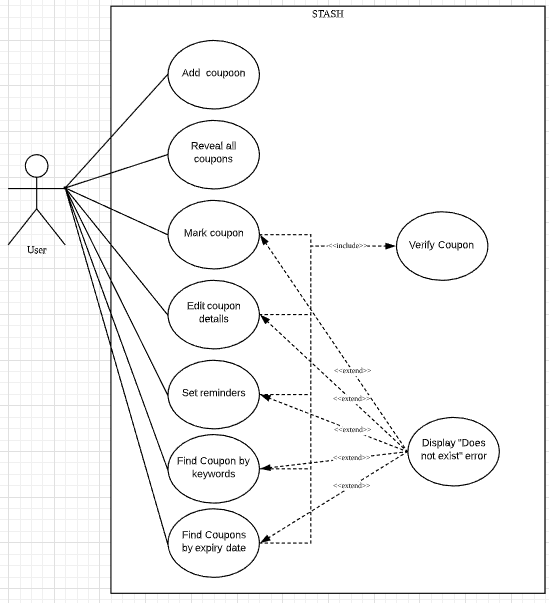
C.1. Use Case: UC1 - Add Coupon
Actor: user
Precondition: User has opened the application
This use case describes how a user uses Coupon Stash to add a new coupon entry.
MSS
-
User keys in command to add coupon.
-
Coupon Stash adds coupon.
-
Coupon Stash informs user that a coupon is added.
Use case ends.
Extensions
-
1a. Coupon Stash detects an invalid format in the entered data.
-
1a1. Coupon Stash requests the user to re-enter the details.
-
1a2. User enters new data.
-
Steps 1a1 - 1a2 are repeated twice until the data entered are correct.
-
Use case resumes from step 2.
-
1a3. User enters wrong data twice.
-
1a4. Coupon Stash clears command line.
-
Use case ends.
-
C.2. Use Case: UC2 - List all coupons
Actor: user
Precondition: User has opened the application
This use case describes how a user uses Coupon Stash to list out all the coupon entries.
MSS
-
User keys in command to list all the coupons.
-
Coupon Stash lists out all coupons.
-
Coupon Stash informs to user of the number of coupons found in the list.
Use case ends.
Extensions
-
1a. Coupon Stash detects an invalid format in the entered data.
-
1a1. Coupon Stash requests the user to re-enter the details.
-
1a2. User enters new data.
-
Steps 1a1 - 1a2 are repeated twice until the data entered are correct.
-
Use case resumes from step 2.
-
1a3. User enters wrong data twice.
-
1a4. Coupon Stash clears command line.
-
Use case ends.
-
-
1b. Coupon Stash detects that the coupon list is empty.
-
1b1. Coupon Stash informs the user that the list is empty.
-
Use case ends
-
C.3. Use Case: UC3 - Mark a coupon as used
Actor: user
Pre-condition: User has opened the application
MSS
-
User keys in command to list all coupons (UC2).
-
User marks coupon as used.
-
Coupon Stash marks the coupon as used.
-
Coupon Stash informs the user the specific coupon that is successfully used.
Use case ends.
Extensions
-
1a. Coupon Stash detects an invalid format in the entered data.
-
1a1. Coupon Stash requests the user to re-enter the details with the correct format.
-
1a2. User enters new data.
-
Steps 1a1 - 1a2 are repeated twice until the data entered are correct.
-
Use case resumes from step 2.
-
-
1b. Coupon Stash detects that the specified coupon does not exist.
-
1b1. Coupon Stash requests the user to enter an index that corresponds with an existing coupon.
-
1b2. User enters a new index.
-
Use case resumes from step 2.
-
-
1c. Coupon Stash detects that the specified coupon has been previously marked as done.
-
1c1. Coupon Stash informs user that the coupon has been previously marked as done.
-
Use case ends.
-
C.4. Use Case: UC4 - Find coupon(s) by keyword(s)
Actor: user
Pre-condition: User has opened the application
This use case describes how a user uses Coupon Stash to find the coupon(s) with keyword(s).
MSS
-
User keys in command to find a coupon based on keyword(s).
-
Matched coupons are displayed.
-
Coupon Stash informs user the number of coupons found.
Use case ends.
Extensions
-
1a. Coupon Stash detects an invalid format in the entered data.
-
1a1. Coupon Stash requests the user to re-enter the details with the correct format.
-
1a2. User enters new data.
-
Steps 1a1 - 1a2 are repeated twice until the data entered are correct.
-
Use case resumes from step 2.
-
-
1b. Coupon Stash detects that the specified coupon does not exist.
-
1b1. Coupon Stash requests the user to enter an index that corresponds with an existing coupon.
-
1b2. User enters a new index.
-
Use case resumes from step 2.
-
C.5. Use Case: UC5 - Edit coupon’s details
Actor: user
Precondition: User has opened the application
This use case describes how a user uses Coupon Stash to edit details of an existing coupon.
MSS
-
User keys in command to list all coupons (UC2).
-
User edits an existing coupon.
-
Coupon Stash updates the coupon details.
-
Coupon Stash informs the user which coupon has been edited.
Use case ends.
Extensions
-
2a. Coupon Stash detects an invalid format in the entered data.
-
2a1. Coupon Stash requests the user to re-enter the details with the correct format.
-
2a2. User enters new data.
-
Steps 2a1 - 2a2 are repeated twice until the data entered are correct.
-
Use case resumes from step 3.
-
-
2b. Coupon Stash detects that the specified coupon does not exist.
-
2b1. Coupon Stash requests the user to enter an index that corresponds with an existing coupon.
-
2b2. User enters a new index.
-
Use case resumes from step 3.
-
C.6. Use Case: UC6 - Set reminder
Actor: user
Precondition: User has opened the application
This use case describes how a user uses Coupon Stash to set reminders for an existing coupon.
MSS
-
User keys in command to list all coupons (UC2).
-
User sets a reminder for an existing coupon.
-
On the day of the input date, a pop up will appear to remind the user about the coupon.
Use case ends.
Extensions
-
2a. Coupon Stash detects an invalid format in the entered data.
-
2a1. Coupon Stash requests the user to re-enter the details with the correct format.
-
2a2. User enters new data.
-
Steps 2a1 - 2a2 are repeated twice until the data entered are correct.
-
Use case resumes from step 3.
-
-
2b. Coupon Stash detects that the specified coupon does not exist.
-
2b1. Coupon Stash requests the user to enter an index that corresponds with an existing coupon.
-
2b2. User enters a new index.
-
Use case resumes from step 3.
-
C.7. Use Case: UC7 - List coupon(s) expiring before date
Actor: user
Precondition: User has opened the application
This use case describes how a user uses Coupon Stash to find the coupon(s) expiring before the input expiry date.
MSS
-
User keys in command to find a coupon based on expiry date.
-
Matched coupons are displayed. Coupon Stash informs the user the number of coupons expiring before the specified date. Use case ends.
Extensions
-
1a. Coupon Stash detects an invalid format in the entered data.
-
1a1. Coupon Stash requests the user to re-enter the details with the correct format.
-
1a2. User enters new data.
-
Steps 1a1 - 1a2 are repeated twice until the data entered are correct.
-
Use case resumes from step 2.
-
-
1b. Coupon Stash detects that the specified coupon does not exist.
-
1b1. Coupon Stash requests the user to enter an index that corresponds with an existing coupon.
-
1b2. User enters a new index.
-
Use case resumes from step 2.
-
C.8. Use Case: UC8 - Delete coupon
Actor: user
This use case describes how a user uses Coupon Stash to delete an existing coupon.
MSS
-
User list all coupons (UC2).
-
User deletes an existing coupon.
-
User confirms its decision during confirmation.
-
Coupon Stash removes the coupon.
Use case ends.
Extensions
-
2a. Coupon Stash detects an invalid format in the entered data.
-
2a1. Coupon Stash requests the user to re-enter the details with the correct format.
-
2a2. User enters new data.
-
Steps 2a1 - 2a2 are repeated twice until the data entered are correct.
-
Use case resumes from step 2.
-
-
2b. Coupon Stash detects that the specified coupon does not exist.
-
2b1. Coupon Stash requests the user to enter an index that corresponds with an existing coupon.
-
2b2. User enters a new index.
-
Use case resumes from step 2.
-
C.9. Use Case: UC9 - Undo previous command
Actor: user
This use case describes how a user undo the previous command in Coupon Stash.
MSS
-
User keys in command to undo a previous command.
-
User confirms its decision during confirmation.
-
Coupon Stash undo the previous command.
-
Coupon Stash informs the user which command has been undone.
Use case ends.
Extensions
-
1a. Coupon Stash detects an invalid format in the entered data.
-
1a1. Coupon Stash requests the user to re-enter the details with the correct format.
-
1a2. User enters new data.
-
Steps 1a1 - 1a2 are repeated twice until the data entered are correct.
-
Use case resumes from step 1.
-
Appendix D: Non-Functional Requirements
-
Coupon Stash works on
common operating systems (OS)that haveJava 11or above installed. -
Coupon Stash can store at least 500 coupons without crashing the application.
-
Coupon Stash can operate without noticeable lag (~2s) when entering commands or interacting with the UI.
-
Coupon Stash caters to users who have above average typing speed, and these users should be able to get tasks completed faster in the application by typing, rather than using the mouse and the UI.
-
Coupon Stash source code should be covered by tests as much as possible.
-
Coupon Stash should be easy to use for users, who are not familiar with coding.
-
All monetary amounts should be accurate up to 2 decimal places.
-
Coupon Stash should be portable.
-
Data files should remain unchanged when transferring from OS to OS.
-
Coupon Stash works perfectly without access to the internet.
-
Coupon Stash supports various types of coupons (e.g. promotional codes, QR code, or barcode) (coming in in v2.0)
Appendix E: Glossary
-
Coupon Stash - the program that makes handling your coupons easier, and also the subject matter of this Developer Guide.
-
common operating system - refers to the most widely seen operating systems for desktop computers.
-
Java 11 - the 11th version of the highly popular Java platform and programming language, on which many software applications are built upon.
-
lag - the phenomenon where some arbitrary user input takes a noticeable and vexatious amount of time to effect a change in the application state.
-
monetary amount - any currency amount (for example, 10.55 may represent 10 dollars and 55 cents, or 10 pounds and 55 pence, or 10 pesos and 55 centavos).
-
operating system - a fundamental software application that runs on a computer, supporting basic functions such as ability to manage computer memory, to allow users to use the device without concern for such technical details.
-
OS (Operating System) - see operating system.
-
promo code - short for promotional code, usually refer to an unique string of letters and numbers that can be entered in some mobile application to redeem certain benefits.
-
SoC (School of Computing) - the School of Computing at the National University of Singapore.
-
source code - a set of instructions, written in a programming language that determine the final application’s internal and external behaviour.
-
UI (User Interface) - a catch-all term referring to how a computer system and a coupon interacts, usually referring to specific elements displayed on the computer screen that the user may interact with such as buttons or text boxes, as well as areas where the computer application displays certain outputs to the user.
Appendix F: Instructions for Manual Testing
Given below are instructions to test the app manually.
| These instructions only provide a starting point for testers to work on; testers are expected to do more exploratory testing. |
F.1. Launch and Shutdown
-
Initial launch
-
Download the jar file and copy into an empty folder
-
Head over to your local Command Line Interface (CLI), and change to the directory where the jar file was saved.
-
Type
java - jar CouponStash.jarin the CLI.
Expected: Shows the GUI with a set of sample coupons.
-
F.2. Adding a coupon
-
Adding a coupon
-
Test case:
add n/Popular Bookstore e/31-12-2020 s/10%
Expected: Coupon Popular Bookstore is added to the list.Start Dateis set to thesystem’s date, while the Remind Date is set to 3 days before the specifiedExpiry Date. In this case, it would be 28-12-2020.
-
F.3. Listing coupons
-
List different type of coupons
-
Test case:
list
Expected: All active coupons are displayed on the list. -
Test case:
list a/
Expected: All archived coupons are displayed on the list. -
Test case:
list u/
Expected: All previously used coupons are displayed on the list.
-
F.4. Deleting a coupon
-
Deleting a coupon while all coupons are listed
-
Prerequisites: List all coupons using the
listcommand. Have at least one coupon in the list. -
Test case:
delete 1
Expected: First contact is deleted from the list. Details of the deleted contact shown in the status message. Timestamp in the status bar is updated. -
Test case:
delete 0
Expected: No coupon is deleted. Error details shown in the status message. -
Other incorrect delete commands to try:
delete,delete x(where x is larger than the list size)
Expected: Similar to previous.
-
F.5. Editing a Coupon
-
Editing a coupon while all coupons are listed
-
Prerequisites: List all coupons using the
listcommand. Have at least one coupon in the list. -
Test case:
edit 1 p/ILOVESTASH
Expected: The first coupon will have its Promo Code changed toILOVESTASH. -
Test case:
edit 1 e/31-12-2021
Expected: The first coupon will have its Expiry Date changed to31-12-2021. -
Test case:
edit 1 l/0
Expected: The first coupon will now have unlimited usage. -
Test case:
edit 1 u/10
Expected: An error message will be thrown, explaining that usage cannot be edited. -
Test case:
edit 1 s/$10 s/Water Bottle
Expected: The first coupon will have its savings changed to $10, and include a Water Bottle item.
-
F.6. Finding a coupon
-
Finds certain coupons by name in Coupon Stash.
-
Prerequisites: Have some coupons in Coupon Stash, preferably the sample data.
-
Test case:
find adidas
Expected: Only the coupon named "Adidas" shows up. -
Test case:
find grabfood
Expected: Only the coupon named "GrabFood" shows up.
-
F.7. Sorting the Coupon Stash
-
Sorts coupons by name, expiry date or remind date in Coupon Stash.
-
Prerequisites: Have some coupons in Coupon Stash, preferably the sample data. The following test cases assumes the commands are run on a set of unmodified sample data.
-
Test case:
sort n/
Expected: The Coupon Stash appears in this order: Adidas, Gong Cha, GrabFood, Lazada, LiHO, Shopee -
Test case:
sort e/
Expected: The Coupon Stash appears in this order: GrabFood (30-04-2020), LiHO (31-05-2020), Gong Cha (30-06-2020), Lazada (30-09-2020), Shopee (31-10-2020), Adidas (31-12-2020) -
Test case:
sort r/
Expected: The Coupon Stash appears in this order: GrabFood (27-04-2020), LiHO (28-05-2020), Gong Cha (27-06-2020), Lazada (27-09-2020), Shopee (28-10-2020), Adidas (28-12-2020)
-
F.8. Listing all expiring coupons
-
Shows coupons that are expiring on a certain date or a certain month.
-
Prerequisites: Have some coupons in Coupon Stash, preferably the sample data. The following test cases assumes the commands are run on a set of unmodified sample data.
-
Test case:
expiring e/31-10-2020
Expected: Shopee (expires on 31-10-2020) appears as the only coupon. -
Test case:
expiring my/4-2020
Expected: GrabFood (expires 30-04-2020) appears as the only coupon
-
F.9. Viewing savings
-
Views savings accumulated in the application
-
Prerequisites: Have some coupons in Coupon Stash, preferably the sample data. The following test cases assumes the commands are run on a set of unmodified sample data.
-
Test case:
saved
Expected: The command result box displays "In total, you have saved $60.00 as well as earned 1x USB-C cable, 1x iPhone case." -
Test case:
saved d/11-3-2020
Expected: The command result box displays "You saved $7.30 on 11 March 2020." (this savings record is attached to the "Gong Cha" coupon). -
Test case:
saved sd/16-3-2020 e/23-3-2020
Expected: The command result box displays "You saved $17.00 between 16 March 2020 and 23 March 2020."
-
F.10. Using a coupon
-
Marks a coupon as used and registers the savings. Depending on whether the coupon is a percentage or monetary amount, you may be required to enter in the original price of the item.
-
Prerequisites: Have some coupons in Coupon Stash that have usage not at the limit, preferably the sample data. The following test cases assumes the commands are run on a set of unmodified sample data.
-
Test case:
list,used 6 $100
Expected: The command result box displays "Used Coupon: GrabFood" and sayings for today increases by $40 (40% of $100 saved).
-
F.11. Archiving a coupon
-
Marks a coupon as archived and hides it from the normal view.
-
Prerequisites: Have some coupons in Coupon Stash that are not already archived. The following test cases assumes the commands are run on a set of unmodified sample data.
-
Test case:
list,archive 5
Expected: The command result box displays "Archived Coupon: LiHO" and LiHO disappears from the displayed coupons. -
Test case:
list a/,unarchive 1
Expected: The command result box displays "Unarchived Coupon: LiHO" and LiHO reappears in the displayed coupons.
-
F.12. Copying a coupon
-
Recreates a coupon as an add command that can be copied and shared to other users of Coupon Stash.
-
Prerequisites: Have some coupons in Coupon Stash that are not already archived. The following test cases assumes the commands are run on a set of unmodified sample data.
-
Test case:
list,copy 1
Expected: Command result box displays "Copied coupon: Adidas" andadd n/Adidas p/30ADIDAS e/31-12-2020 s/30.0% s/Adidas Cap l/1is added to the operating system’s clipboard.
-
F.13. Sharing a coupon
-
Takes an image of the coupon as it appears in Coupon Stash and opens the file save dialogue box of your operating system so you can save the image to your computer.
-
Prerequisites: Have some coupons in Coupon Stash that are not already archived. The following test cases assumes the commands are run on a set of unmodified sample data.
-
Test case:
list,share 2
Expected: The operating system prompts you to save "Gong Cha.png" to a location on your computer.
-
F.14. Undoing a command
-
Undoes the previous command entered, only if the command resulted in a change to the coupons.
-
Prerequisites: At least one command that modified a coupon was previously entered.
-
Test case:
add n/Test e/1-1-5050 s/$40,undoExpected: A new coupon named "Test" is added, and then removed again onceundois run.
-
F.15. Going to a month on the calendar
-
Navigates the calendar to jump to a certain month and year, without the need for clicking buttons in the User Interface.
-
Prerequisites: None
-
Test case:
goto my/4-5678
Expected: The calendar shows the month of April, in the year 5678.
-
F.16. Expanding a coupon
-
Opens a new window with full details of the Coupon, such as a list of all the saveable items.
-
Prerequisites: Have at least one coupon displayed in Coupon Stash. The following test cases assumes the commands are run on a set of unmodified sample data.
-
Test case:
list,expand 2
Expected: A window appears that shows the full history of coupon usage for the Gong Cha coupon.
-
F.17. Setting currency symbol
-
Changes the currency symbol used by Coupon Stash when displaying amounts saved and when interpreting monetary amounts in commands.
-
Prerequisites: None. The following test cases assumes the commands are run with the unmodified sample user preferences.
-
Test case:
setcurrency ms/RM
Expected: Command result box displays "Money symbol changed from $ to RM!" and coupons shown are updated to display savings in RM instead of $.
-
F.18. Viewing help page
-
Opens the user guide of Coupon Stash in another window.
-
Prerequisites: None.
-
Test case:
help
Expected: A web browser window opens, showing the Coupon Stash User Guide.
-
Appendix G: Efforts
Coupon Stash is the first team-based software engineering project for all of us. Without much experience, we faced many difficulties in coordinating our features and codes. Since Coupon Stash is User Interface intensive, we had to learn JavaFX comprehensively to fulfil the high standards that we set for ourselves. Learning a new Framework was as good as learning a new language in itself, taking us some time to understand how to fully utilize it.
Each of us would push commits every other day every week to try and complete our tasking too. While our product is similar to AB3 in terms of data fields, we push it further by adding functionality to these fields. The intertwining of these functionality was the most difficult part about this project. We would usually try to sort out the implementation on chat, but there are times where one of us would mess up the implementation somewhere afterwards, causing a bit of debugging. We also try to apply as much of our learning from the textbook, but again without much practice, it would usually take us a few iterations and discussions to correct our code. Nonetheless, we learnt a lot from this project throughout these 7 weeks.
What we believe we did well in was getting our project workflow right from the start. Using Github’s project board, issue tracker and branch protections, we were able to help each other spot mistakes, ensuring that our master branch was always working. Even though we started as strangers, the long weekly discussions that we have brought us close! We are definitely proud of the product that we created, and believe that it serves its purpose well.
